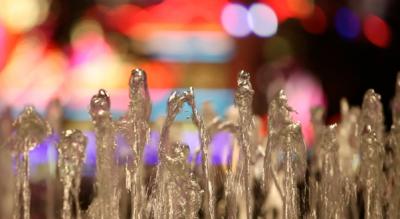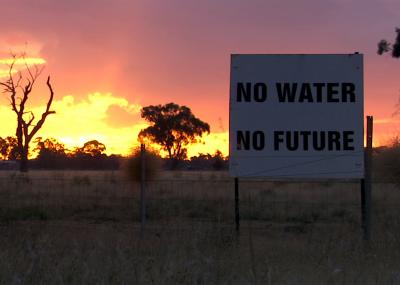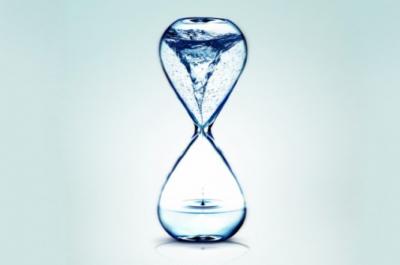By: debbie lynn elias

There is no doubt that we face a fresh water crisis in the world today. And yes, I say “world” as this is a matter of global proportion. However, because media focus of drought and contamination is primarily on “third world countries” or Africa, those in the United States rarely take notice, absent getting fined by the city for watering their lawns on the wrong day. Oscar winning director Jessica Yu attempts to cure that defect with her latest documentary, LAST CALL AT THE OASIS.
As you may all remember from first and second grade, the water cycle is very clear cut. Water rains down upon the Earth as liquid, vapor, snow, ice, etc. and is reclaimed by the ground or used for farming and personal use, only to have the water go back into the system through evaporation, recycling, reclamation, ground water absorption, etc. It’s a perpetual hamster wheel, so to speak. So, why then, with Mother Nature’s perfect cyclic structure, are water levels depleting and a shortage occurring? How water is disappearing faster than the cyclic nature of its “creation” gets the mind thinking and asking questions that one hopes to have answers to within the film, but those answers are never sufficiently realized, explained or supported.

Opening with great interest and passion about our diminishing water supply (and integrating our elementary school science lesson), much attention is paid to Las Vegas, sparking interest and setting an accessible tone. A city built in a desert that must have water piped in to satisfy the needs or its residents and tourism department, in many respects Las Vegas is the poster child for watering a waterless land. But at what cost? Statistics are bandied about as to specific water usage by residents and the flowing casino fountains (the film indicates casinos account for only 3% usage of all Vegas water, yet actual statistics in September 2011 indicate 7% usage), but the supporting data falls short, particularly when talking population growth but failing to mention how the population of the area has declined due to the economy. We are shown rows and rows of houses, but how many are actually occupied now? The Las Vegas discussion really sets the stage for the water pipeline litigation currently pending, a topic which is merely glossed over.

With panoramic vistas of Lake Mead, Hoover Dam, the Sierra Nevadas, we are psychologically lulled into the pristine beauty of fresh clean water. But this lovely imagery is quickly destroyed as the documentary turns from water shortages to water quality and morphs into an infomercial or advertorial for Erin Brokovich and her self-named Erin Brokovich Consulting. Capitalizing on Brokovich’s image thanks to Julia Roberts’ Oscar winning portrayal of her in Erin Brokovich, the bulk of Brokovich’s screen time is spent mimicking scenes from the movie as she stands up in a room full of people shaking her head in disbelief, rehashing Hinkley and PG&E, bad-mouthing the EPA and telling people they have no one on their side but for her. The only difference is that this time, the setting is Midland, Texas. With a completely staged look and feel (including sitting on a porch with a nice local Midland woman talking about her grandbabies in the swimming pool vs. Marg Helgenberger and Julia Roberts in Hinkley talking about Helgenberger’s character’s children), Brokovich’s presence and the formatted images with feigned interest only serve to discredit the film and the importance of the issue at hand, turning this into a “docudrama” at best. Also disturbing is Brokovich’s “investigator” Bob Bowcock. At no time does the film ever provide us with any credentials or information as to what type of “investigator” he is. Noted is that he really only serves to show that he’s the one sticking his hands in dirty water and not Brokovich. Nothing establishes credibility of why we should listen to him or why or what he does. A very memorable and disturbing scene is footage of actual Senate hearings at which Brokovich was speaking. As Brokovich portrays herself as the great white hope, Barbara Boxer pointedly questions her as to “why” people would contact her as opposed to the EPA or other agencies. The film abruptly cuts away, never providing us with an answer.

Vacillating between biology, frog hormones, agricultural concerns, economic impact on farmers, water reclamation, desalination, purification of waste for drinking water, opining from environmentalists and conservationists, there is a lot of information imparted – too much, in fact. And let’s not overlook some disgusting visuals of sewage fecal waste and hundreds of dirty condoms floating in frothy filth. While some of the information impacted is quite interesting and has the ability to open the door to debate and discussion, time is so short that we are given just a snippet, leaving us uninformed and unable to comment or develop our own opinions. Trying to incorporate so many different issues under one umbrella only serves to make the documentary convoluted and confusing – something an audience will not have patience to try and sift through. The film should have stayed on point with the course charted by the intro – disappearing water and the shortage of water. Waste management, toxicity, poisoning, reclamation, global warming and Al Gore all took the film into so many different directions and so many different topics, each of which should be its own documentary.
Equally disappointing is that statistics are bandied about and commented on as being “high”, “horrible”, “killers”, yet, but for exception, the film fails to provide baseline numbers for what is “normal” or “acceptable.”
A glaring omission is a complete lack of information, commentary or rebuttal from Lisa Jackson at the EPA or any other agency or research facility. There is no balance to the issues presented making the film completely one-sided without explanatory factual bases for arguments presented. Also noted is the debate between conservationists, water engineers and professionals, and environmentalists and whether conservation is enough to solve the water shortage. When alleged authorities are at odds and one actually hears the words “conservation isn’t the answer”, that’s like waving a red flag at a bull; in the minds of many, they just got the go ahead to not conserve.
There is no specific timeline for when this documentary was made. There are 2009 references and old news footage from 2008-2009 (and if you check online for news stories, the Midland TX events there occurred in 2009), but I don’t recall seeing anything that makes LAST CALL AT THE OASIS current within the past year nor is there any epilogue or follow-up. I would have liked to at least see the most recent information included, even in a closing title card. For example, in December, the U.S. Bureau of Reclamation was predicting a roughly 11-foot rise in Lake Mead over the next year based on the 2010-11 snow pack. However, now due to less snow in 2011-12, the bureau anticipates a drop of 13 feet of water by January 2013. The documentary never makes real reference to the fact that lake/water levels can rise and that there is documented evidence of this occurring. Very very negative tone.

A high point? The opening title credits and bits of inspired animated graphics which are peppered throughout are not only entertaining and well done, but prove attention getting. They also aid in alluding to the complexity of the situation and illustrate areas of water usage which we don’t normally think about, but, as with the rest of the film, then never explains the usage.
LAST CALL AT THE OASIS may open some eyes and spark some debate on this very serious and frightening issue of water, but sadly, will undoubtedly quickly lose its audience due to over-reaching insuffiency. Personally, reading up on and understanding the work of Friends of the Earth Middle East (www.foeme.org) will do more to not only help the world understand and tackle the water crisis and other environmental issues, but be an example of how to achieve peace.
Directed by Jessica Yu.












